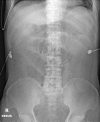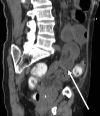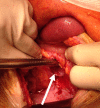Intramesosigmoid hernia complicated by strangulated small-bowel obstruction
- PMID: 27432828
- PMCID: PMC4956957
- DOI: 10.1136/bcr-2016-216369
Intramesosigmoid hernia complicated by strangulated small-bowel obstruction
Abstract
An intramesosigmoid hernia is 1 of the 3 rare types of sigmoid-related hernias that could be complicated by intestinal obstruction. Our patient presented with a clinical picture of intestinal obstruction. CT scan showed features of strangulated small-bowel obstruction secondary to a sigmoid-related hernia. This was confirmed intraoperatively to be an intramesosigmoid hernia. We share the radiological findings with intraoperative surgical correlation and discuss the imaging features described in the literature.
2016 BMJ Publishing Group Ltd.
Figures






Similar articles
-
Laparoscopic treatment of small bowel strangulation caused by an intramesosigmoid hernia and review of literature.BMJ Case Rep. 2020 Apr 29;13(4):e233627. doi: 10.1136/bcr-2019-233627. BMJ Case Rep. 2020. PMID: 32354762 Free PMC article. Review.
-
Small bowel obstruction due to an intramesosigmoid hernia diagnosed by multidetector row computed tomography: a case report.Osaka City Med J. 2010 Dec;56(2):37-45. Osaka City Med J. 2010. PMID: 21466128
-
Left paraduodenal hernia causing small bowel obstruction in an adolescent patient.J Pediatr Surg. 2009 Dec;44(12):2417-9. doi: 10.1016/j.jpedsurg.2009.09.020. J Pediatr Surg. 2009. PMID: 20006041
-
Education and imaging. Gastrointestinal: a rare cause of small bowel obstruction, paracecal hernia.J Gastroenterol Hepatol. 2015 Mar;30(3):437. doi: 10.1111/jgh.12817. J Gastroenterol Hepatol. 2015. PMID: 25707789 No abstract available.
-
Left paraduodenal hernia causing small bowel obstruction.J Gastrointest Surg. 2014 Jul;18(7):1377-8. doi: 10.1007/s11605-014-2517-1. Epub 2014 Apr 26. J Gastrointest Surg. 2014. PMID: 24771461 Review.
Cited by
-
Intersigmoid Hernia: A Forgotten Diagnosis-A Systematic Review of the Literature over Anatomical, Diagnostic, Surgical, and Medicolegal Aspects.Emerg Med Int. 2020 Jun 1;2020:4891796. doi: 10.1155/2020/4891796. eCollection 2020. Emerg Med Int. 2020. PMID: 32566302 Free PMC article. Review.
-
Laparoscopic treatment of small bowel strangulation caused by an intramesosigmoid hernia and review of literature.BMJ Case Rep. 2020 Apr 29;13(4):e233627. doi: 10.1136/bcr-2019-233627. BMJ Case Rep. 2020. PMID: 32354762 Free PMC article. Review.
-
Small bowel obstruction secondary to intramesosigmoid hernia.BMJ Case Rep. 2019 May 23;12(5):e228766. doi: 10.1136/bcr-2018-228766. BMJ Case Rep. 2019. PMID: 31126929 Free PMC article.
References
Publication types
MeSH terms
LinkOut - more resources
Full Text Sources
Other Literature Sources
Medical
